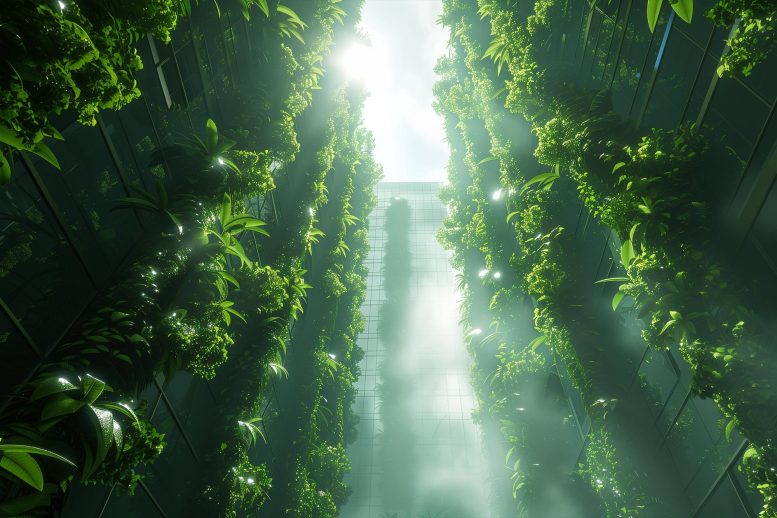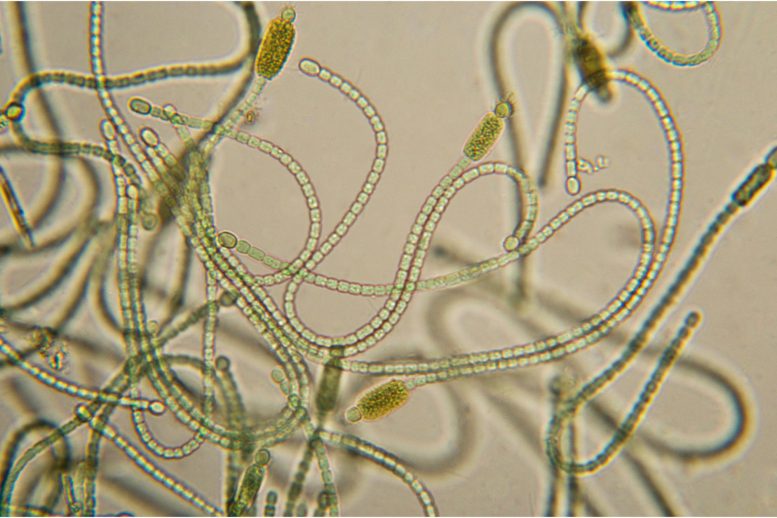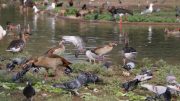
Scientists discover a new enzyme function in cyanobacteria that could lead to better carbon-capturing crops, potentially increasing food production and enhancing climate resilience. Credit: SciTechDaily.com
Researchers have uncovered the mechanism of a crucial enzyme, described as “hidden in nature’s blueprint,” illuminating how cells control key processes in carbon fixation, a process fundamental for life on Earth.
The discovery could help engineer climate-resilient crops capable of sucking carbon dioxide from the atmosphere more efficiently, helping to produce more food in the process. The breakthrough was made by scientists from The Australian National University (ANU) and the University of Newcastle (UoN).
The research, published on May 10 in the journal Science Advances, demonstrates a previously unknown function of an enzyme called carboxysomal carbonic anhydrase (CsoSCA), which is found in cyanobacteria – also called blue-green algae – to maximize the microorganisms’ ability to extract carbon dioxide from the atmosphere.
Cyanobacteria are commonly known for their toxic blooms in lakes and rivers. But these little blue-green bugs are widespread, also living in the world’s oceans.
Although they can pose an environmental hazard, the researchers describe them as “tiny carbon superheroes.” Through the process of photosynthesis, they play an important role in capturing about 12 percent of the world’s carbon dioxide each year.

Cyanobacteria are a group of photosynthetic bacteria, often referred to as “blue-green algae,” although they are prokaryotes and not true algae. These organisms are found in a wide range of aquatic and terrestrial environments, from oceans to freshwater to bare rock. Cyanobacteria are known for their ability to perform oxygenic photosynthesis, meaning they produce oxygen as a byproduct, similar to plants. This process is critical for life on Earth as it significantly contributes to the production of oxygen in the atmosphere.
First author and PhD researcher Sacha Pulsford, from ANU, describes how remarkably efficient these microorganisms are at capturing carbon.
“Unlike plants, cyanobacteria have a system called a carbon dioxide concentrating mechanism (CCM), which allows them to fix carbon from the atmosphere and turn it into sugars at a significantly faster rate than standard plants and crop species,” Ms. Pulsford said.
At the heart of the CCM are large protein compartments called carboxysomes. These structures are responsible for sequestering carbon dioxide, housing CsoSCA and another enzyme called Rubisco.
The enzymes CsoSCA and Rubisco work in unison, demonstrating the highly efficient nature of the CCM. The CsoSCA works to create a high local concentration of carbon dioxide inside the carboxysome that Rubisco can then gobble up and turn into sugars for the cell to eat.
Lead author Dr. Ben Long, from UoN, said: “Until now, scientists were unsure how the CsoSCA enzyme is controlled. Our study focused on unraveling this mystery, particularly in a major group of cyanobacteria found across the globe. What we found was completely unexpected.
“The CsoSCA enzyme dances to the tune of another molecule called RuBP, which activates it like a switch.
“Think of photosynthesis like making a sandwich. Carbon dioxide from the air is the filling, but a photosynthetic cell needs to provide the bread. That’s RuBP.
“Just like you need bread to make a sandwich, the rate of turning carbon dioxide into sugar depends on how fast RuBP is supplied.
“How fast the CsoSCA enzyme supplies carbon dioxide to Rubisco is dependent on how much RuBP is present. When there’s enough, the enzyme is switched on. But if the cell runs out of RuBP, the enzyme is switched off, making the system highly tuned and efficient.
“Surprisingly, the CsoSCA enzyme has been embedded in nature’s blueprint all along, waiting to be discovered.”
The scientists say engineering crops that are more efficient at capturing and utilizing carbon dioxide would provide a huge boost for the agricultural industry by vastly improving crop yield while reducing the demand for nitrogen fertilizer and irrigation systems.
It would also ensure the world’s food systems are more resilient to climate change.
Ms Pulsford said: “Understanding how the CCM works not only enriches our knowledge of natural processes fundamental to Earth’s biogeochemistry but may also guide us in creating sustainable solutions to some of the biggest environmental challenges the world is facing.”
Reference: “Cyanobacterial α-carboxysome carbonic anhydrase is allosterically regulated by the Rubisco substrate RuBP” by Sacha B. Pulsford, Megan A. Outram, Britta Förster, Timothy Rhodes, Simon J. Williams, Murray R. Badger, G. Dean Price, Colin J. Jackson and Benedict M. Long, 10 May 2024, Science Advances.
DOI: 10.1126/sciadv.adk7283









It’s Dr Pulsford
Sucking all the carbon from the atmosphere is just gonna kill the plants. It’s not gonna solve the climate issues that supposedly exist.
You’re stupid in two completely orthogonal dimensions, that’s quite a achievement.
By providingv plants with foliar nutrients you can guickly increase photosynthesis from most plants operating at 15 to 20% of their genetic photosynthetic capacity to 40 or 50% in as little as 24 hours. To do this you need magnesium, iron, and manganese in a chemically reduced form that the plant can immediately use. And does not require any trans genetic manipulation. By synthetic capacity the plant has more energy to work with so it’s immune system is driven to protect it from insects and disease and it throws excess carbohydrate into the soil to build soil biology which in turn digest the geology to provide the plant the minerals it needs in the form they can use. Plus it is the most effective way to sequester carbon back into the soils, 1/3 of of soil carbon has gone into the atmosphere as carbon dioxide by poor farming practices.
Edit By: increasing photo(synthetic capacity)…